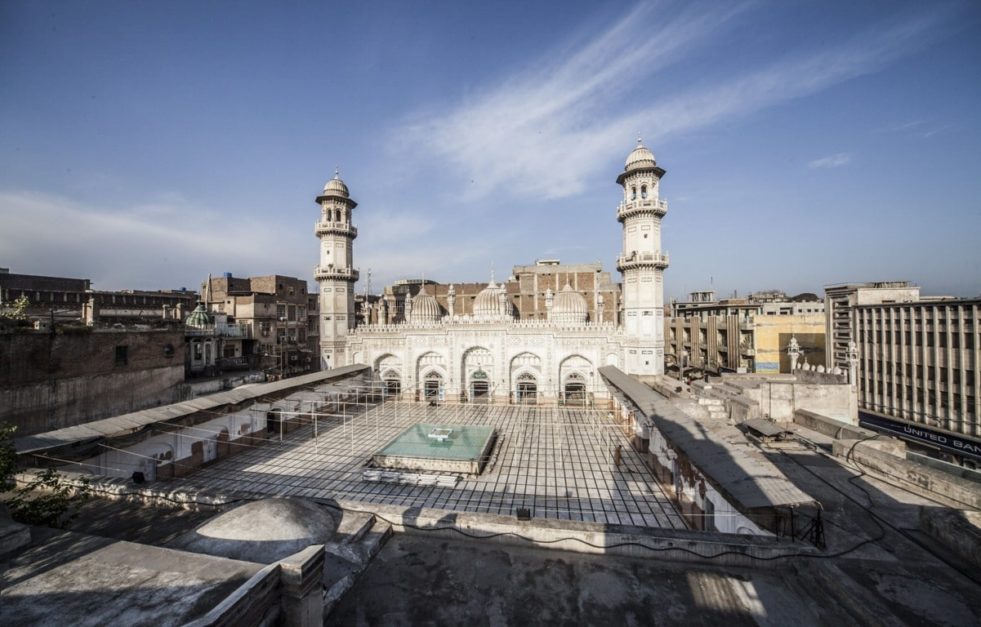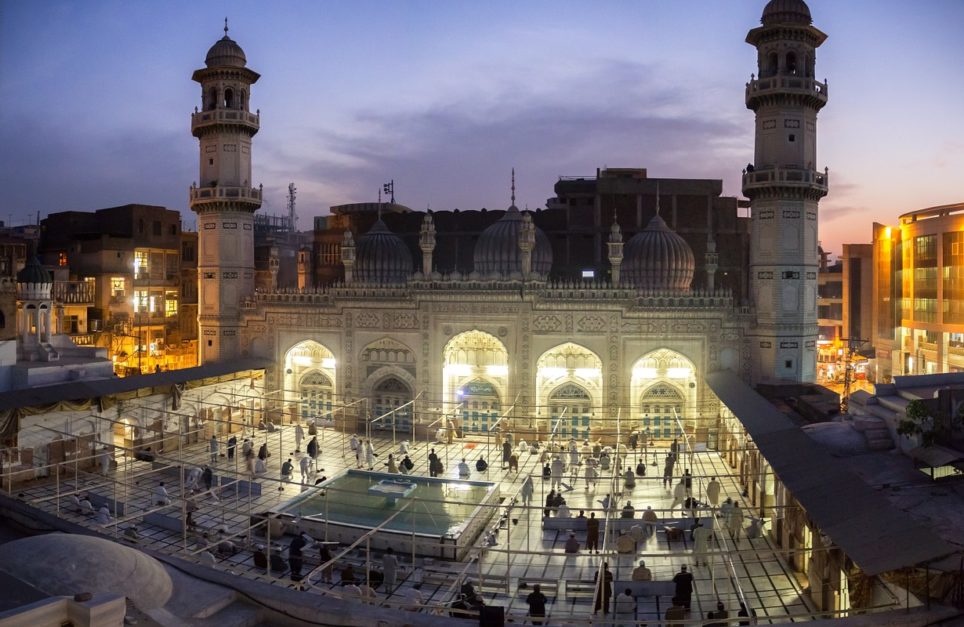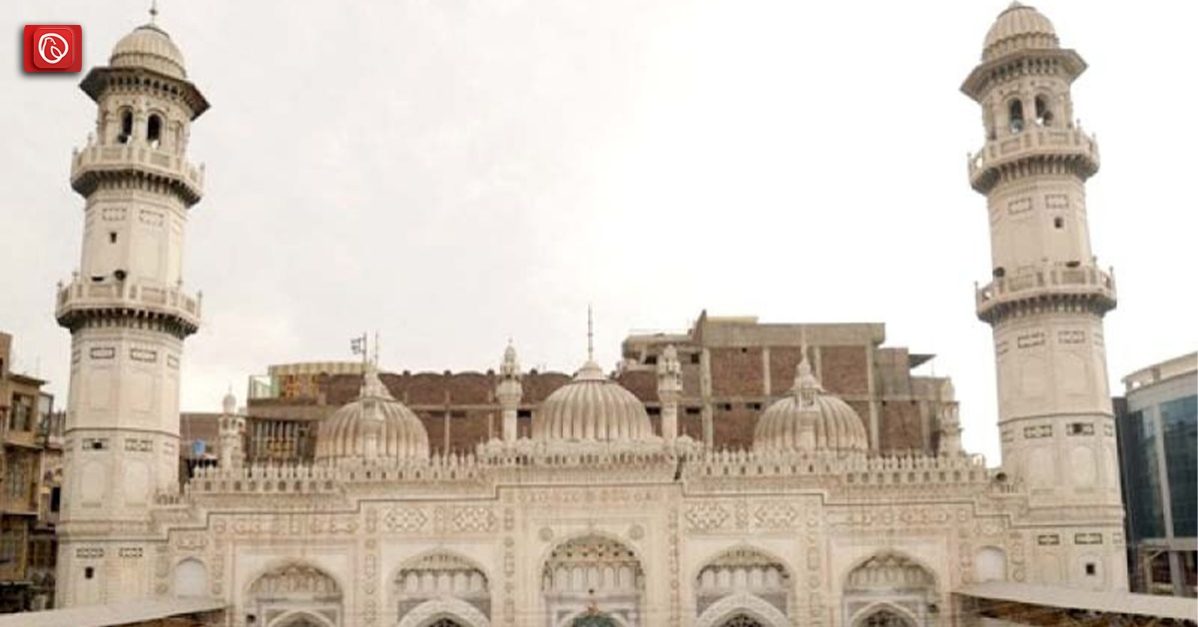Located in the busy streets of Androon Shehr Bazaar, Peshawar, you’ll find the Mahabat Khan Mosque, a striking example of Mughal architecture and a true historical gem. Built back in 1670 during Emperor Shahjahan’s rule, this mosque has quite the story to tell.
Its tall minarets, though impressive, were once used for a rather grim purpose – as a place to hang criminals instead of using traditional gallows. But this mosque isn’t just about its architecture or dark past. It has played a unique part in the region’s history, from the Mughal era to the tumultuous days of the Soviet-Afghan conflict. As you step through the entrance, you’ll find a vast prayer courtyard that welcomes both worshippers and curious tourists.
Join Graana.com in this virtual journey of discovering the intriguing history and timeless beauty of the Mahabat Khan Mosque, a place that holds captivating stories in the heart of Peshawar.
| Location | Peshawar, Pakistan |
| Coordinates | 34° 0’38.25″N 71°34’23.40″E |
| Faith | Islam |
| Category | Mosque |
| Completed Date | 1970 A.D. |
| Order to Construct | Nawab Mohabbat Khan |
| Status | Mughal governor of Peshawar |
| Rank | Largest In Peshawar |
| Architecture Style | Mughal Architecture |
| Dome(s) | 3 |
| Minaret(s) | 2 |
History of Masjid Mahabat Khan

The Mahabat Khan Mosque, a resplendent architectural wonder located in Peshawar’s old city, bears a history as rich and storied as the city itself. The magnificent mosque, built in the seventeenth century, is a tribute to the indomitable spirit of the Mughal era, its name forever linked with Mahabat Khan Mirza Lerharsib. Mahabat Khan, a prominent figure of his time, and is one of the famous places in Peshawar.
The exact year of the mosque’s completion is shrouded in historical ambiguity, with conflicting accounts pointing to three potential years: 1627, 1630, and 1670 A.D. However, among these, 1670 A.D. is considered the most likely completion date. This period was marked by the reign of the Mughal monarch Shah Jahan, and it was Mahabat Khan himself who oversaw the construction of this architectural masterpiece.
The mosque’s history, like many other Muslim structures of its time, was marred by turbulent events. During the Sikh invasion of Punjab, it suffered the same fate as numerous other Islamic buildings, enduring looting, destruction, and plunder. Its striking blue coloured tiles and ornate plates were removed mercilessly and taken away, a painful chapter in the mosque’s existence.
Perhaps one of the darkest episodes in the mosque’s history was during the governance of General Avitabile Peshawar’s governor. Known for his cruelty, he would have local men thrown from the roof of the mosque’s minaret before breakfast as a means to subdue the uncivilised tribesmen. His barbaric actions have since become part of the local folklore, with “Abu Tabela” serving as a dire warning to misbehaving children, a dishonesty of ‘Avitabile.’
Architecture & Design
The Masjid Mahabat Khan, a famous mosque located in the old city of Peshawar, is a stunning example of Mughal architecture. It’s surrounded by gold and silversmith shops. The entrance may be narrow, but it’s impressively massive and leads to a spacious prayer courtyard.
In the centre of this courtyard, there’s a beautiful blue-tiled pool for ablution, with rooms on each side and the main prayer hall on the western end. Inside the main hall, you’ll find lavish decorations with floral designs and Arabic calligraphy.
The outside of the prayer hall is adorned with six smaller decorative minarets, and the roofline is decorated with lots of small decorative features. The mosque has three entrances, and the walls and domes are intricately carved with various designs.
What makes the Masjid Mahabat Khan unique is its distinct architectural style that’s visually captivating. Its combination of beauty, detailed craftsmanship, and historical significance makes it a must-see in Peshawar’s old city. Hence, the mosque is one of the historical places in Peshawar.
Restoration of Masjid Mahabat Khan

The Mahabat Mosque has a unique history marked by its destruction and looting during the Sikh rule. In an effort to draw more tourists, significant renovation work was undertaken.
Restoring this Mughal-era structure to its original design presented considerable challenges, and this rebuilding process spanned several years. The renovation project aimed not only to enhance the mosque’s architectural aesthetics but also to preserve its historical and archaeological significance.
The government allocated substantial financial resources, amounting to millions of rupees, to restore this vital part of the national heritage. While it’s uncertain when the renovation of the mosque will be completed, diligent efforts have been made to revitalize and protect this cultural gem.
How to Reach Masjid Mahabat Khan
To visit this Mosque, head to the Old Bazaar within Peshawar’s historic city. Local residents will be more than happy to guide you through the area. From there, proceed along Kachahri Road towards Chowk Yadgar, where you can park your vehicle. Then, walk towards the west into the Bazaar until you reach the Mosque, situated at the highest point of the street.
FAQs
Following are a afew FAQs regarding Masjid Mahabat Khan:
1. What is Masjid Mahabat Khan, and where is it located?
Masjid Mahabat Khan is a historic mosque located in the old city of Peshawar, Pakistan. It is a prominent example of Mughal architecture and a significant cultural and religious site.
2. Can tourists visit Masjid Mahabat Khan?
Yes, Masjid Mahabat Khan is open to tourists. Visitors are welcome to explore the mosque and its surroundings. It’s a popular tourist destination in the northern Pakistan for both locals and tourists interested in history and architecture.
3. What is the history of Masjid Mahabat Khan?
The mosque has a rich history, having been built during the Mughal era. It was once damaged and looted during Sikh rule and later underwent a significant renovation to restore its former glory.
4. What are the notable architectural features of the mosque?
The mosque boasts stunning architectural features, including a large prayer courtyard, a blue-tiled ablution pond, intricately decorated interiors with floral work and calligraphy, fluted domes, and decorative minarets.
5. How can I get to Masjid Mahabat Khan?
To reach the mosque, you can go to the Old Bazaar in Peshawar’s old city. Locals are usually willing to guide you through the area. Drive along Kachahri Road to Chowk Yadgar, where you can park your car. Then, simply walk west into the Bazaar to reach the mosque.
6. Is there an entrance fee to visit Masjid Mahabat Khan?
Generally, there is no entrance fee to visit the mosque. However, it’s a good practice to make a small donation to support the maintenance and preservation of this historical site.
7. Are there any specific visiting hours for the mosque?
The mosque is usually open during daylight hours. However, it’s a good idea to check with local authorities or guides for the most accurate visiting hours, as they may vary.
8. Is photography allowed inside the mosque?
While people often allow photography, we recommend asking for permission and being respectful of the worshippers and the sacred space when taking photos.
9. Are there any nearby attractions to visit in the vicinity of Masjid Mahabat Khan?
Yes, the old city of Peshawar is filled with historical sites, bazaars, and other places of interest. Some nearby attractions include Chowk Yadgar, Qissa Khwani Bazaar, and some historical forts of Pakistan.
10. Is Masjid Mahabat Khan still used for religious purposes?
Yes, people actively worship at the mosque, and they hold daily prayers there.
In conclusion, Masjid Mahabat Khan stands as a testament to the enduring beauty and historical significance of Mughal architecture. Located in the centre of Peshawar’s old city, this mosque beckons to tourists and history enthusiasts alike, offering a glimpse into a rich past marked by both destruction and restoration.
Its breathtaking architectural features, coupled with the warmth and hospitality of the local community, make it a must-visit destination. With its cultural importance, historical relevance, and spiritual significance, Masjid Mahabat Khan remains a cherished jewel in the vibrant tapestry of Pakistan’s heritage.
This was all about Masjid Mahabat Khan. For more information, visit Graana.com.




